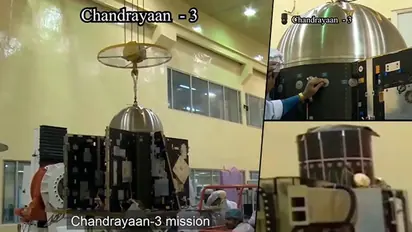ISRO drops first glimpse of Chandrayaan-3 mission, to launch in August 2022

Synopsis
Aside from Chandrayaan-3, the 17-minute video includes information about the country's future Aditya L1 mission and the Gaganyaan mission, which will take Indian astronauts into space.
The first images of the Chndrayaan-3 expedition to the Moon have finally arrived, after a series of delays caused by the COVID-19 pandemic-induced lockdown. The photographs were revealed in a video named "Space on Wheels" by the Indian Space & Research Organisation (ISRO), which features 75 satellites launched by India.
The footage purports to depict the Chandrayaan-3 lander, which will touchdown on the moon. The mission is a follow-up to the Chandrayaan-2 mission, which regrettably crashed on the Moon's dark side in 2019. The documentary depicts the Chandrayaan-3 lander, which will perform India's second moon landing attempt. Other ISRO projects shown in the video include Gaganyaan, the Venus orbiter, and Project NISAR, a US-India collaboration.
ISRO has stated that it will attempt to launch the long-awaited mission by August of this year, although this is challenging given the need for more hardware testing. The Department of Space stated in a letter answer in February of this year that development on Chandrayaan-3 is proceeding and that it will be launched in August of this year.
Also Read | Celestial spectacle: Rare ‘planet parade’ to light up skies as four planets line up in a row this week
The mission has been postponed because to Covid-19, according to Minister of Science and Technology Dr. Jitendra Singh, who stated that "reprioritization of programmes has taken place in the backdrop of space sector reforms and newly implemented demand-driven models."
Aside from Chandrayaan-3, the 17-minute video includes information about the country's future Aditya L1 mission and the Gaganyaan mission, which will take Indian astronauts into space.
The Aditya L1 mission, which will be launched from the first Lagrange point of the Earth-Sun system, will investigate the dynamics and causes of coronal mass ejections. India has previously been collaborating with the European Space Agency to establish a network to follow lunar and solar missions.
Also Read | From Rakesh Sharma to Kalpana Chawla: Remember astronauts who made India proud